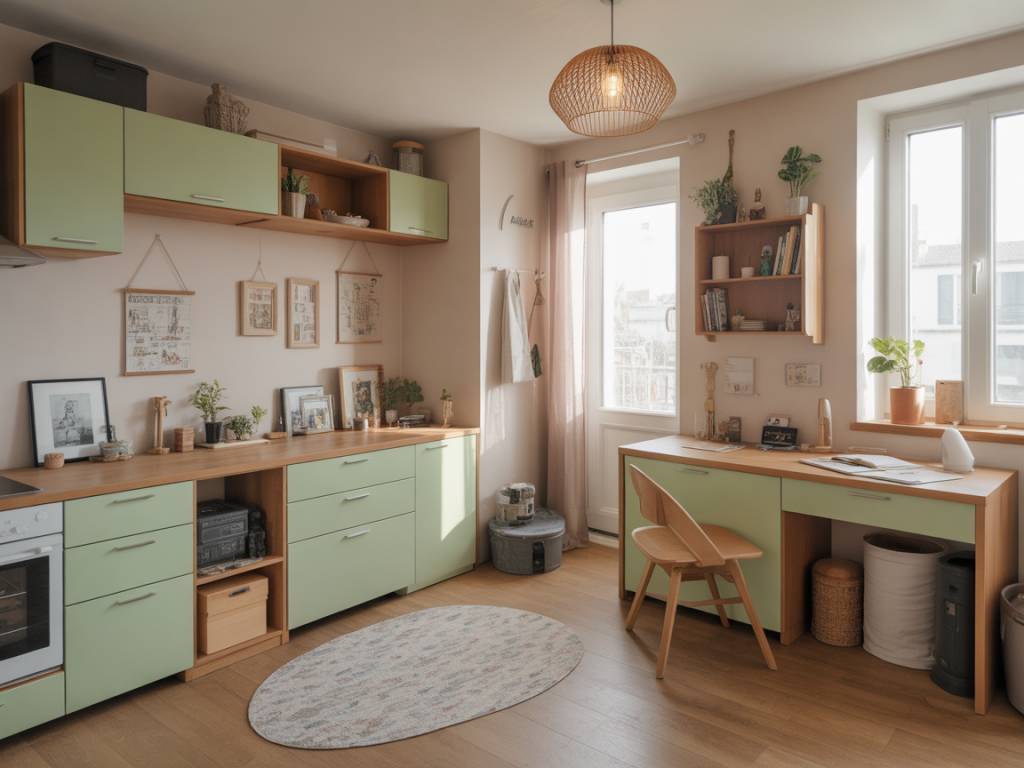Why Install a Vertical Garden in a Tiny House?
With the rise of micro-living and minimalism, homeowners are looking for smart solutions that combine beauty and utility. Creating a vertical garden wall — also known as a green wall or living wall — inside or outside a tiny home offers an impressive way to achieve both decoration and space-saving functionality. It’s a design choice that aligns perfectly with the sustainable, compact lifestyle many are embracing today.
In a home where square footage is at a premium, a vertical garden allows space to be optimized creatively. Unlike traditional potted plants, which consume scarce horizontal surfaces, a green wall saves floor space while bringing natural elements indoors, improving air quality, and enhancing well-being. It’s no surprise that interior designers and architects alike recommend this feature for modern small homes.
Benefits of Vertical Gardens in Small Spaces
Installing a vertical garden in your tiny house is about more than aesthetics. It offers a wide range of practical and environmental benefits. Here are just a few:
- Space Efficiency: Wall space is often underutilized. A vertical garden takes advantage of vertical surfaces to grow herbs, flowers, or decorative foliage without sacrificing floor area.
- Air Purification: Many houseplants are known for their ability to remove toxins from the air, leading to cleaner and healthier indoor environments.
- Improved Insulation: A living wall can act as an additional layer of insulation, tempering indoor temperatures and reducing heating or cooling needs.
- Psychological Benefits: Exposure to greenery has been shown to reduce stress, increase productivity, and improve mood — especially important in the compact environments of small homes.
- Custom Aesthetics: With endless design possibilities, a vertical garden can become a bespoke focal point, shaped and styled to suit any décor theme — from rustic wooden arrangements to sleek, modern panels.
Choosing the Right Plants for Your Vertical Garden Wall
The success of a green wall in a small home depends largely on plant selection. It’s important to choose species that match the indoor climate, light exposure, and your maintenance preferences. Some low-maintenance, air-purifying, and visually appealing options include:
- Pothos: Extremely adaptable and fast-growing, perfect for low-light situations.
- Philodendron: A lush, trailing option that adds depth and volume to your vertical installation.
- Spider Plant: Hardy and easily propagated, ideal for high-humidity areas like bathrooms.
- Ferns (e.g., Boston Fern, Maidenhair): Provide texture and thrive in indirect light.
- Succulents: For sunnier zones, succulents like echeveria or burro’s tail offer a sculptural touch and require minimal watering.
- Herbs (e.g., basil, mint, thyme): Combine functionality and freshness by incorporating edible plants into your living wall.
Make sure that plants chosen have similar watering and light requirements, especially when grown in the same vertical structure. Consistency helps to simplify care and extends the longevity of your green wall.
Design Ideas for Vertical Gardens in Tiny Homes
Whether your aesthetic leans toward industrial chic, Scandinavian minimalism, or cottage charm, there’s a vertical garden design to match. These popular design approaches work well in limited spaces:
- Modular Planter Panels: These grids can be mounted on walls and filled with interchangeable pots, making it easy to refresh your green wall seasonally.
- Pocket Garden Fabric Panels: Vertical pockets made of felt or canvas allow plants to be inserted easily — a flexible and budget-friendly option.
- Wooden Pallet Walls: Repurposed pallets are perfect for rustic interiors. They provide a charming, handcrafted look and double as bookshelves or storage nooks.
- Hanging Planter Systems: Attach multiple planters vertically using ropes or a metal frame. This concept brings a bohemian, airy feel to the room.
- Built-in Green Walls: For a seamless look, incorporate the garden into a partition wall or a recessed nook designed specifically for greenery.
Tailoring the vertical garden’s location—whether it’s in the kitchen to grow herbs, in the living room as a vibrant feature wall, or even in a well-lit bathroom for tropical plants—makes all the difference in maximizing its impact in your small home.
Maintenance and Care Tips for Living Walls
One common misconception is that vertical gardens are hard to maintain. In reality, with the right setup and planning, they can be surprisingly low-maintenance. Here are a few care tips:
- Lighting: Make sure your wall receives adequate light. Supplement with LED grow lights if your indoor space lacks natural sunlight.
- Watering System: Consider an integrated drip irrigation system to automate watering and minimize mess. For smaller green walls, manual watering with a spray bottle works just fine.
- Drainage: Protect your walls by adding a water-retaining layer and a waterproof back panel to avoid moisture damage.
- Regular Trimming: Prune trailing plants to maintain shape and remove dead foliage to encourage fresh growth.
- Fertilization: Feed your plants monthly with a diluted liquid fertilizer to keep them healthy, especially during active growing seasons.
An added tip: rotate your plants occasionally if they are not evenly lit, to ensure balanced growth and vitality.
Where to Buy Vertical Garden Kits and Accessories
With the popularity of urban gardening and sustainable living, numerous retailers now offer vertical garden kits tailored for small spaces. Look for high-quality materials, smart irrigation solutions, and easy installation methods. Some recommended options include:
- Woolly Pocket: Offers soft-sided planters ideal for interiors with a modern edge.
- Living Wall Planters on Etsy: Unique, handmade options that cater to bespoke small-space needs.
- IKEA’s Green Wall Product Line: Affordable and modular, great for beginners looking to experiment with vertical gardening.
- Gardener’s Supply Co.: Sells self-watering vertical garden setups, perfect for forgetful plant parents.
Alternatively, building your own DIY wall garden using recycled materials like pallets, mason jars, or trellises can be both cost-effective and creatively fulfilling. Just be sure to use non-toxic, plant-safe finishes when crafting your supports.
A Smart Blend of Nature and Functionality
In the world of tiny living, every design decision counts. A vertical garden delivers not just greenhouse-worthy beauty but also tangible benefits—adding tranquility, reducing clutter, increasing oxygen, and transforming bland walls into vibrant, living surfaces. It’s an inventive way to bring the outdoors in without encroaching on your valuable floor space. Whether you’re a beginner gardener or a seasoned plant enthusiast, making room for vertical greenery is a step toward a more mindful and eco-conscious lifestyle.

